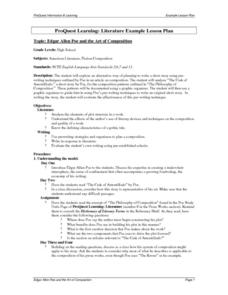Curated OER
Edgar Allen Poe And The Art Of Composition
High schoolers evaluate several works by Edgar Allen Poe based on the criteria in his essay, "The Philosophy of Composotion" Their analysis is documented using a graphic organizer. Learners begin the pre-writing process for their own...
Curated OER
Tales of the Supernatural
Students explore the origins and development of a literary genre. They investigate how shared imaginative concerns link the members of a literary period and compare works of literature from different eras.
Curated OER
Encounter with a Skull (Tae dokuro, 1890)
Students read and analyze a short story by Koda Rohan. They conduct research, read and discuss a biography of the author, identify examples of Japanese and Buddhist symbolism in the story, and write an original story.
Curated OER
African-American Art and the Political Dissent during the Harlem Renaissance
Students are introduced to the culture of African American art. Using the internet, they research the events surrounding the Harlem Renaissance and discover how it produced a wide variety of art and literature. To end the lesson, by...
Curated OER
Symbolism
Students engage in a lesson about symbolism while reviewing the work of Edgar Allen Poe. They review the definition of symbolism and use it to list the symbols in his work. They write a journal about how the author uses many literary...
Curated OER
Numbers in Art
Students choose a number from one to twelve and tell a number story about it. They listen to the teacher read "Numbers in Art" by Lucy Micklethwait. Students choose three numbers from one to twelve and view works of art while looking for...
Curated OER
"Encounter with a Skull"
Students read a story twice. The first time they read it is without contextual information. They read it with the contextual information.
Other popular searches
- American Gothic Literature
- Epitaph Literature Gothic
- Gothic Literature Twilight
- Gothic Literature Worksheets
- Gothic Literature 6 Grade
- Southern Gothic Literature
- Gothic Literature Anaylsis








